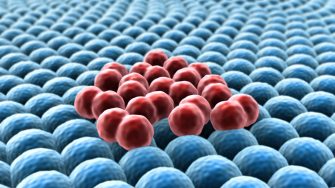
Regenerative Medicine
In the regenerative medicine focus area of the ACN, researchers are developing new materials and methods to exert control over lineage determination in vitro and in vivo. This involves the development of designer interfaces at culture surfaces, on targeting nanomaterials, and within 3D scaffolds, for directing differentiation and de-/trans-differentiation. At the core of this challenge is the recognition that mammalian cells respond to a myriad of soluble and insoluble cues to specify lineage, thus requiring tight control over the spatiotemporal presentation of signals at multiple length scales. Projects in this area include molecularly defined micro- and nano-structured materials for directing cell fate, model tumour microenvironments for cancer research, materials to prime autologous regenerative cells, and hydrogels for organoid engineering.
Cell And Matrix Engineering
Cell state in tissue is ruled by a multivariate presentation of signals that orchestrate diverse forms and functions. Using hydrogel microengineering and 3D printing techniques we are exploring how biochemical (matrix composition and presentation), biophysical (geometry, topography, and viscoelasticity), and biological (paracrine and juxtacrine signals) cues in the cell and tissue microenvironment orchestrate cell state, matrix synthesis, and hierarchical assembly. We currently explore multiple cell systems for matrix directed cell engineering including mesenchymal stromal cells, neural stem cells and induced pluripotent stem cells.
Biomimetic Composite Materials
Our tissues are composed of composite materials of biopolymers and ceramic structures, with hierarchical order for guiding cell and tissue organisation. Using micro- and nano- fabrication techniques we design and develop composite biomaterials that recapitulate these architectures. We also aim to devise new hybrid biomaterials with additional functionality (e.g. sensing and actuation).
Arrays and Model Systems
Natural biomaterials have evolved from a multifactorial and combinatorial process involving a range of distinct molecular components, leading to complex structure and function that is often more than the sum of the individual parts. We aim to dissect these structure-activity relations by designing high throughput platforms and high content imaging approaches for screening the individual versus combined effects of multivariate biological cues on guiding stem cell differentiation.
Bone regeneration
- New technique to immobilize bioactive molecules to the surface of ceramic scaffolds to ensure spatiotemporal release of bone morphogenetic protein-2 for treatment of large bone defects.
- Utilising 3D printing technique and computational modelling to fabricate modular load bearing composite system for spinal fusion.
Osteogenic and angiogenic properties of synthetic, porous and ion doped bone precursor mimicked nanoparticles in interaction with mesenchymal stem cells and endothelial cells.
